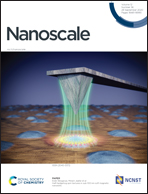Carbon nanostructures as a scaffold for human embryonic stem cell differentiation toward photoreceptor precursors†
Abstract
Carbon nanomaterials have been introduced as a scaffold for various biological applications due to their unique physical and electrical properties. Here we studied carbon nanotubes (CNTs) and carbon nanofibers (CNFs) as scaffold materials for the differentiation of human embryonic stem cells (hESCs) towards photoreceptor precursor cells (PRPs). We report on their cytoxicity, their effect on cell morphology, cell-surface interface and the differentiation process. To this end, hESCs were differentiated into PRPs on carbon nanofibers (CNFs), long horizontal CNTs (LHCNTs), vertically aligned CNTs (VACNTs) or glass (control) surfaces. The differentiated cells were investigated by immunohistochemistry, fluorescence imaging and electron microscopy. Our results revealed that the investigated nanomaterials were not cytotoxic to the cells during the differentiation process. The surface interface effect on the cells was apparent, affecting cell directionality, migration and morphology. Interestingly, cell fate was not dependent on the substrate type, as inferred from the similar dynamics of the loss of pluripotency and the comparable expression levels of the photoreceptor marker Crx for all investigated substrates. These results are important for better understanding the effect of nanomaterial surface interaction with differentiating neural cells in general, and for future use of these materials as scaffolds for differentiating photoreceptors for vision restoration in particular.



 Please wait while we load your content...
Please wait while we load your content...